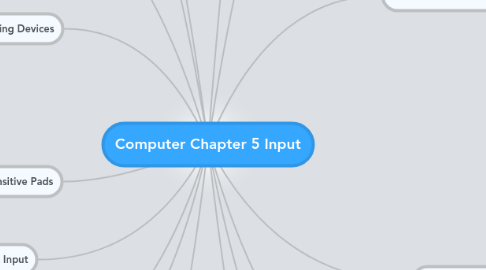
1. 1.The Keyboard
1.1. Is an input device that contains keys users press to enter data and instructions into a computer
1.2. Insertion point
1.3. Wired Keyboards and Wireless Keyboards
1.4. Ergonomics incorporates comfort
2. 2.Pointing Devices
2.1. A pointing device is an input device that allows a user to control a pointer on the screen
2.2. A pointer is a small symbol on the screen whose location and shape change as a user moves a pointing device
3. 3.Mouse
3.1. A mouse is a pointing device that fits under the palm of your hand comfortably
3.1.1. Most widely used pointing device on desktop computers
3.2. A mouse can be wired or wireless
3.3. Mouse operations
3.3.1. Point
3.3.2. Click
3.3.3. Right-click
3.3.4. Double-click
3.3.5. Triple-click
3.3.6. Drag Rotate wheel
3.3.7. Press wheel Free-spin wheel
3.3.8. Tilt wheel
3.3.9. Press thumb button
4. 4.Other Pointing Devices
4.1. Trackball
4.2. Touchpad
4.3. Pointing Stick
5. 5.Touch Screens and Touch-Sensitive Pads
5.1. A touch screen is a touch-sensitive display device
5.1.1. Microsoft Surface
5.1.2. Touch-sensitive pads
6. 6.Pen Input
6.1. With pen input, you touch a stylus or digital pen on a flat surface to write, draw, or make selections
7. 7.Other Input for Smart Phones
8. 8.Game Controllers
8.1. game controller as the input device that directs movements and actions of on-screen objects
8.1.1. Gamepads
8.1.2. Joysticks and Wheels
8.1.3. Light guns
8.1.4. Dance pads
8.1.5. Motion-sensing controllers
9. 9.Digital Cameras
9.1. A digital camera is a mobile device that allows users to take pictures and store them digitally
9.1.1. Studio cameras
9.1.2. Field cameras
9.1.3. Point-and-shoot camera
9.2. Two factors affect the quality of digital camera photos
9.2.1. Resolution
9.2.2. Number of bits stored in each pixel
10. 10.Voice Input
10.1. Voice input is the process of entering input by speaking into a microphone
10.2. Voice recognition is the computer’s capability of distinguishing spoken words
10.3. Audio input is the process of entering any sound into the computer
10.3.1. Speech
10.3.2. Music
10.3.3. Sound Effects
10.4. Music production software allows users to record, compose, mix, and edit music and sounds
11. 11.Video Input
11.1. Video input is the process of capturing full-motion images and storing them on a computer’s storage medium
11.1.1. Record video on a digital video (DV) camera or use a video capture card to convert analog signals to digital
11.1.2. Connect the camera to a port on the system unit
11.1.3. Transfer video and images
11.2. Video Editing on Your Computer
11.3. A Web cam is a type of digital video camera that enables a user to:
11.3.1. Capture video and still images
11.3.2. Send e-mail messages with video attachments
11.3.3. Add live images to instant messages
11.3.4. Broadcast live images over the Internet
11.3.5. Make video telephone calls
11.4. A video conference is a meeting between two or more geographically separated people
12. 12.Scanners and Reading Devices
12.1. Flatbed
12.2. Pen or Handheld
12.3. Sheet-fed
12.4. Drum
12.5. Optical character recognition (OCR) involves reading characters from ordinary documents
12.6. A turnaround document is a document you return to the company that creates and sends it
12.7. Optical mark recognition (OMR) reads hand-drawn marks such as small circles or rectangles
12.8. A bar code reader, also called a bar code scanner uses laser beams to read bar codes
12.9. RFID (radio frequency identification) uses radio signals to communicate with a tag placed in or attached to an object An RFID reader reads information on the tag via radio waves RFID can track
12.9.1. Inventory
12.9.2. Employee wardrobes
12.9.3. Location of soldiers
12.9.4. Airline baggage
12.9.5. Gauging tire pressure and temperature
12.9.6. Library books
12.9.7. Prepaid tolls
13. 13.Biometric Input
13.1. Biometrics authenticates a person’s identity by verifying a personal characteristic
13.1.1. Fingerprint reader
13.1.2. Face recognition system
13.1.3. Hand geometry system
13.1.4. Voice verification system
13.1.5. Signature verification system
13.1.6. Iris recognition system
13.1.7. Retinal scanners
14. 14.Terminals
14.1. A terminal is a computer that allows users to send data to and/or receive information from a host computer
14.1.1. A POS terminal records purchases, processes payment, and updates inventory
14.1.2. An automated teller machine (ATM) allows users to access their bank accounts
14.1.3. A DVD kiosk is a self-service DVD rental machine
15. 15.Putting It All Together
16. 16.Input Devices for Physically Challenged Users
16.1. Several input devices are available to assist physically challenged users:
16.1.1. Keyguard
16.1.2. Keyboards with larger keys
16.1.3. On-screen keyboard
16.1.4. Various pointing devices
16.1.5. Head-mounted pointer
16.1.6. Gesture recognition
16.1.7. Computerized implant devices
